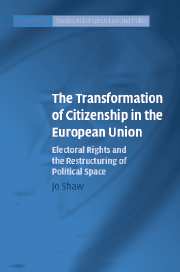 The Transformation of Citizenship in the European Union
The Transformation of Citizenship in the European Union from PART II - The past, present and future of EU electoral rights
Published online by Cambridge University Press: 05 June 2015
Introduction
This chapter presents the story of EU electoral rights from the date of the coming into force of the Treaty of Maastricht in 1993 onwards. Thus it covers a period in which these electoral rights have become crystallised in EU law and practice in the form of the two EU implementing directives, 1 and in national law and practice. However, the chapter will concentrate on presenting the story from the perspective of EU law and policy. So far as national developments and the process of national adjustment are concerned, these are considered primarily from the perspective of the requirements of EU law, bearing in mind the supremacy of EU law, and the obligation on the Member States under Article 10 EC to ‘take all appropriate measures, whether general or particular, to ensure the fulfilment of the obligations arising under this Treaty’. The perspective from within the Member States, especially so far as concerns the relationship between EU electoral rights and other electoral rights under national law, as well as the interdependence between electoral rights and the wider framework of immigration law and policy, nationality law, and policies on minorities, will reappear in those specific national contexts in Chapters 8, 9 and 10. Possible extensions of the scope of EU electoral rights, derived from some of the controversies which they raise within the framework of EU law, are discussed in Chapters 6 and 7.
The impact and significance of EU electoral rights
Tracing the story of EU electoral rights through from 1993 to the present day, this chapter inevitably raises the question of the impact and significance of EU electoral rights, particularly as viewed from the perspective of the evolution of EU citizenship. In its Second Report on Citizenship of the Union in 1997, the Commission commented that:
Voting rights for non-national Union citizens are indeed the most important of the new rights conferred by the Treaty.
To save this book to your Kindle, first ensure [email protected] is added to your Approved Personal Document E-mail List under your Personal Document Settings on the Manage Your Content and Devices page of your Amazon account. Then enter the ‘name’ part of your Kindle email address below. Find out more about saving to your Kindle.
Note you can select to save to either the @free.kindle.com or @kindle.com variations. ‘@free.kindle.com’ emails are free but can only be saved to your device when it is connected to wi-fi. ‘@kindle.com’ emails can be delivered even when you are not connected to wi-fi, but note that service fees apply.
Find out more about the Kindle Personal Document Service.
To save content items to your account, please confirm that you agree to abide by our usage policies. If this is the first time you use this feature, you will be asked to authorise Cambridge Core to connect with your account. Find out more about saving content to Dropbox.
To save content items to your account, please confirm that you agree to abide by our usage policies. If this is the first time you use this feature, you will be asked to authorise Cambridge Core to connect with your account. Find out more about saving content to Google Drive.